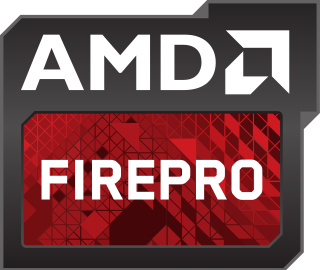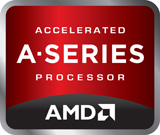
Advanced Micro Devices, Inc. (AMD) is an American multinational corporation and technology company headquartered in Santa Clara, California and maintains significant operations in Austin, Texas. AMD is a hardware and fabless company that designs and develops central processing units (CPUs), graphics processing units (GPUs), field-programmable gate arrays (FPGAs), system-on-chip (SoC), and high-performance compute solutions. AMD serves a wide range of business and consumer markets, including gaming, data centers, artificial intelligence (AI), and embedded systems.

ATI Technologies Inc. was a Canadian semiconductor technology corporation based in Markham, Ontario, that specialized in the development of graphics processing units and chipsets. Founded in 1985, the company listed publicly in 1993 and was acquired by AMD in 2006. As a major fabless semiconductor company, ATI conducted research and development in-house and outsourced the manufacturing and assembly of its products. With the decline and eventual bankruptcy of 3dfx in 2000, ATI and its chief rival Nvidia emerged as the two dominant players in the graphics processors industry, eventually forcing other manufacturers into niche roles.

Radeon is a brand of computer products, including graphics processing units, random-access memory, RAM disk software, and solid-state drives, produced by Radeon Technologies Group, a division of AMD. The brand was launched in 2000 by ATI Technologies, which was acquired by AMD in 2006 for US$5.4 billion.
x86 virtualization is the use of hardware-assisted virtualization capabilities on an x86/x86-64 CPU.

AMD FirePro was AMD's brand of graphics cards designed for use in workstations and servers running professional Computer-aided design (CAD), Computer-generated imagery (CGI), Digital content creation (DCC), and High-performance computing/GPGPU applications. The GPU chips on FirePro-branded graphics cards are identical to the ones used on Radeon-branded graphics cards. The end products differentiate substantially by the provided graphics device drivers and through the available professional support for the software. The product line is split into two categories: "W" workstation series focusing on workstation and primarily focusing on graphics and display, and "S" server series focused on virtualization and GPGPU/High-performance computing.
The AMD mobile platform is an open platform for laptops from AMD. Though little marketing was done on this platform, it has been competing with the Centrino platform in the segment to gain more marketshare. Each platform has its own specification, catching up the latest technology developments. Since the acquisition of ATI, AMD began to include Mobility Radeon GPUs and AMD chipsets as part of the requirements of the mobile platform; the first of such platforms is the Puma platform.

AMD Accelerated Processing Unit (APU), formerly known as Fusion, is a series of 64-bit microprocessors from Advanced Micro Devices (AMD), combining a general-purpose AMD64 central processing unit (CPU) and 3D integrated graphics processing unit (IGPU) on a single die.
The AMD 700 chipset series is a set of chipsets designed by ATI for AMD Phenom processors to be sold under the AMD brand. Several members were launched in the end of 2007 and the first half of 2008, others launched throughout the rest of 2008.
The Radeon R700 is the engineering codename for a graphics processing unit series developed by Advanced Micro Devices under the ATI brand name. The foundation chip, codenamed RV770, was announced and demonstrated on June 16, 2008 as part of the FireStream 9250 and Cinema 2.0 initiative launch media event, with official release of the Radeon HD 4800 series on June 25, 2008. Other variants include enthusiast-oriented RV790, mainstream product RV730, RV740 and entry-level RV710.
The AMD 690 chipset series is an integrated graphics chipset family which was developed and manufactured by AMD subsidiary ATI for both AMD and Intel platforms focusing on both desktop and mobile computing markets. The corresponding chipset for the Intel platform has a marketing name of Radeon Xpress 1200 series.
Unified Video Decoder is the name given to AMD's dedicated video decoding ASIC. There are multiple versions implementing a multitude of video codecs, such as H.264 and VC-1.
The Evergreen series is a family of GPUs developed by Advanced Micro Devices for its Radeon line under the ATI brand name. It was employed in Radeon HD 5000 graphics card series and competed directly with Nvidia's GeForce 400 series.

AMD Software is a device driver and utility software package for AMD's Radeon graphics cards and APUs. Its graphical user interface is built with Qt and is compatible with 64-bit Windows and Linux distributions.

A mini PC is a small-sized, inexpensive, low-power, legacy-free desktop computer designed for basic tasks such as web browsing, accessing web-based applications, document processing, and audio/video playback.
The HP Pavilion dv2 was a series of 12" notebooks manufactured by Hewlett-Packard Company.
Lenovo's line of Essential desktops is a collection of budget-conscious machines designed for consumers, and advertised as being "affordable, space saving, and energy efficient". The Essential desktop line is different from both Lenovo's ThinkCentre line and Lenovo's IdeaCentre line. Lenovo defines its ThinkCentre desktops as business-oriented computers, while the IdeaCentre desktops are meant primarily for entertainment. The Essential range of desktops can be categorized as being between the two – meant more for ordinary everyday use.
The graphics processing unit (GPU) codenamed the Radeon R600 is the foundation of the Radeon HD 2000/3000 series and the FireGL 2007 series video cards developed by ATI Technologies.
The graphics processing unit (GPU) codenamed Radeon R600 is the foundation of the Radeon HD 2000 series and the FireGL 2007 series video cards developed by ATI Technologies. The HD 2000 cards competed with nVidia's GeForce 8 series.
Video Code Engine is AMD's video encoding application-specific integrated circuit implementing the video codec H.264/MPEG-4 AVC. Since 2012 it was integrated into all of their GPUs and APUs except Oland.

On June 26, 2007, Dell released the new Inspiron desktop series, under the Dell Inspiron branding, as a replacement to the Dell Dimension desktop computers.









